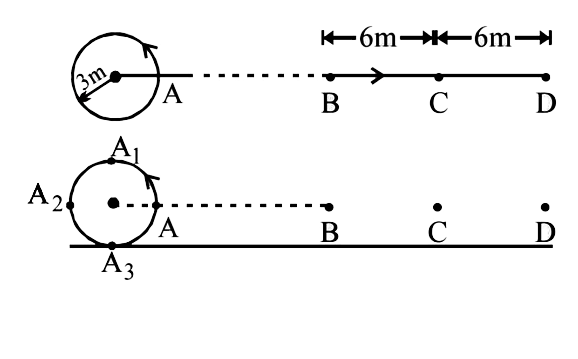Given below are some functions of x and t to represent the displacement (transverse or longitudinal) of an elastic wave. Some which of these represent (i) a travelling wave, (ii) a stationary wave or (iii) none at all:
(a) y=2cos(3x)sin(10t)
(b) y=2√x−vt
(c ) y=3sin(5x−0.5t)+4cos(5x−0.5t)
(d) y=cosxsint+cos2xsin2tSolution in Gujrati
The correct Answer is:(i) Stationary wave
(ii) Uncceptable functiom for any travelling wave
(iii) Travelling harmonic wave
(iv) Superposition of two stationary waves
Step by step video & image solution for Given below are some functions of x and t to represent the displacement (transverse or longitudinal) of an elastic wave. Some which of these represent (i) a travelling wave, (ii) a stationary wave or (iii) none at all: (a) y = 2 cos (3 x) sin (10 t) (b) y = 2 sqrt(x - v t) (c ) y = 3 sin (5 x - 0.5 t) + 4 cos(5 x - 0.5 t) (d) y = cos x sin t + cos 2x sin 2t by Physics experts to help you in doubts & scoring excellent marks in Class 11 exams.
Updated on:21/07/2023Topper's Solved these Questions
- WAVES AND OSCILLATIONSBOOK - ALLEN CHAPTER - WAVES AND OSCILLATIONSEXERCISE - Part-1(Exercise-04)[B]
13 Videos
- WAVES AND OSCILLATIONSBOOK - ALLEN CHAPTER - WAVES AND OSCILLATIONSEXERCISE - Part-1(Exercise-05)[A]
28 Videos
- WAVES AND OSCILLATIONSBOOK - ALLEN CHAPTER - WAVES AND OSCILLATIONSEXERCISE - Part-1(Exercise-03)
31 Videos
- SEMICONDUCTORSBOOK - ALLEN CHAPTER - SEMICONDUCTORSEXERCISE - Part-3(Exercise-4)
50 Videos
Similar Questions
A source of sound is moving along a circular orbit of radius 3meter with an angular velocity of 10rad/s. A sound detector located far away from the source is executing linear simple harmonic motion along the line BD with an amplitude BC=CD=6meters. The frequency of oscillation of the detector is 5π per second. The source is at the point A when the detector is at the point B. If the source emits a continuous sound wave of frequency 340Hz, Find the maximum and the minimum frequencies recorded by the detector.

View SolutionTube A has both ends open while tube B has one closed, otherwise they are identical. The ratio of fundamental frequency of tube AandB is
View SolutionStatement-1 : Sound travels faster in moist air
Statement-2 : The density of moist air is less then density of dry air.
View SolutionAt absolute zero temperature Si acts as ……..
View SolutionGiven below are some functions of x and t to represent the displacement (transverse or longitudinal) of an elastic wave. State which of these represent (i) a travelling wave, (ii) a stationary wave or (iii) none at all
(a) y=2cis(3x)sin(10t)
(b) y=
(c) y=3sin(5x−0.5t)+cos(5x−5t)
(d) y=cosxsint+cos2xsin2t
View SolutionGiven below are some functions of x and t to represent the displacement the displacement ( transverseor longitudinal ) of an elastic wave. State which of these represent (i) atravelling wave, (ii) a stationary wave or ( iii) none at all :
(a) y=2cos(3x)sin(10t)
(b) y=2√x−vt
(c ) y=3sin(5x−0.5t)+4cos(5x−0.5t)
(d) ycosxsint+cos2xsin2t
View Solutionनीचे किसी प्रत्यास्थ तरंग (अनुप्रस्थ अथवा अनुदैर्घ्य ) के विस्थापन को निरूपित करने वाले x तथा t के फलन दिए गए है यह बताइये की इसमें से कौन (i ) प्रगामी तरंग को (ii ) अप्रगामी तरंग को ,(iii ) इनमे से किसी भी तरंग को नही निरुपित करता है। -
y=3sin(5x−0.5t)+4cos(5x−0.5t)
View Solutionनीचे किसी प्रत्यास्थ तरंग (अनुप्रस्थ अथवा अनुदैर्घ्य ) के विस्थापन को निरूपित करने वाले x तथा t के फलन दिए गए है यह बताइये की कौन (i ) प्रगामी तरंग को (ii ) अप्रगामी तरंग को ,(iii ) इनमे से किसी भी तरंग को नही निरुपित करता है। -
y=cosxsint+cos2xsin2t
View SolutionGiven below are some functions of x and t to represent the displacement (transversal or longitudinal) of an elastic wave. Identify the waves . y = 2 cos (3x) sin (10t)
View SolutionGiven below are some functions of x and t to represent the displacement (transversal or longitudinal) of an elastic wave. Identify the waves .
y=2√x−vt
View SolutionGiven below are some functions of x and t to represent the displacement (transversal or longitudinal) of an elastic wave. Identify the waves .
y = 3 sin (5x -0 . 5 t) + 4 cos (5 x - 0 . 5 t)
View SolutionGiven below are some functions of x and t to represent the displacement (transversal or longitudinal) of an elastic wave. Identify the waves . y = cos x sin t + cos 2 x sin 2 t
View SolutionGiven below are some functions of x and t to represent the displacement (transverse or longitudinal) of an elastic wave. Some which of these represent (i) a travelling wave, (ii) a stationary wave or (iii) none at all:
(a) y=2cos(3x)sin(10t)
(b) y=2√x−vt
(c ) y=3sin(5x−0.5t)+4cos(5x−0.5t)
(d) y=cosxsint+cos2xsin2t
View SolutionGiven below are some functions of x and t to represent the displacement (transverse or longitudinal) of an elastic wave. Some which of these represent (i) a travelling wave, (ii) a stationary wave or (iii) none at all: (a) y = 2 cos (3 x) sin (10 t) (b) y = 2 sqrt(x - v t) (c ) y = 3 sin (5 x - 0.5 t) + 4 cos(5 x - 0.5 t) (d) y = cos x sin t + cos 2x sin 2t
View SolutionGiven below are some functions of x and t to represent the displacement (transverse or longitudinal) of an elastic wave. Some which of these represent (i) a travelling wave, (ii) a stationary wave or (iii) none at all:
(a) y=2cos(3x)sin(10t)
(b) y=2√x−vt
(c ) y=3sin(5x−0.5t)+4cos(5x−0.5t)
(d) y=cosxsint+cos2xsin2t
View SolutionGiven below are some functions of x and t to represent the displacement (transverse or longitudinal) of an elastic wave. Some which of these represent (i) a travelling wave, (ii) a stationary wave or (iii) none at all:
(a) y=2cos(3x)sin(10t)
(b) y=2√x−vt
(c ) y=3sin(5x−0.5t)+4cos(5x−0.5t)
(d) y=cosxsint+cos2xsin2t
View Solution
